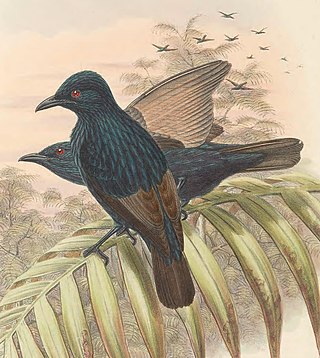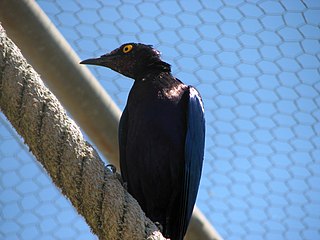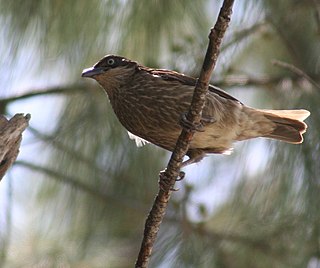The Mauke starling or mysterious starling is an extinct species of starling found on the island of Mauke, Cook Islands. The binomen is the result of Buller's misreading of the name inornata on the specimen label. As he seems to have genuinely believed this spelling to be correct, the binomial, although it has no meaning, is valid.

The Pohnpei starling, also known as Pohnpei mountain starling or Ponape mountain starling, is an extremely rare or possibly extinct bird from the family of starlings (Sturnidae). It is endemic to the island of Pohnpei in the Pacific Ocean. It was called "sie" by the Pohnpei islanders. It was named after the Austrian ornithologist August von Pelzeln (1825–1891).
The Tasman starling was described in 1836 by John Gould as a species which occurred on both Norfolk Island and Lord Howe Island. In 1928 Australian ornithologist Gregory Mathews recognized that the plumage of the race from Lord Howe Island was much browner and more greyish than the plumage of the Norfolk Island race and split the species into two forms, the Norfolk starling, and the Lord Howe starling. Both subspecies are now extinct, thus so the species.

The singing starling is a medium-sized starling.

The Samoan starling is a large starling of the family Sturnidae. It is found in the Samoan Islands. The species has a dark brown, glossy appearance, with a long bill. Its natural habitat is tropical moist forest on volcanic islands, where it is common and more conspicuous than the Polynesian starling, which is found in the same habitat. Vocalizations include various whistles and other sounds. This starling feeds on a variety of fruits, especially guava, and insects. Little is known of its mating or social habits, but it appears to nest year-round, in tree cavities. Its eggs are pale blue.
The white-eyed starling is a species of starling in the family Sturnidae. It is found in the Solomon Islands archipelago. Its natural habitats are subtropical or tropical moist lowland forests and subtropical or tropical swamps. It is threatened by habitat loss.

The Rarotonga starling is a species of starling in the family Sturnidae. It is endemic to the Cook Islands.

The Tanimbar starling is a species of starling in the family Sturnidae. It is endemic to Indonesia.
The Makira starling, also known as the San Cristobal starling, is a species of starling in the family Sturnidae. It is endemic to the Solomon Islands. Its natural habitat is subtropical or tropical moist lowland forests.

The brown-winged starling is a species of starling in the family Sturnidae. It is found in the Solomon Islands archipelago. Its natural habitat is subtropical or tropical moist lowland forests.
The Rennell starling is a species of starling in the family Sturnidae. It is endemic to Rennell Island in the Solomon Islands.

The long-tailed starling is a species of starling in the family Sturnidae. It is endemic to the Schouten Islands off West Papua, in Indonesia, an important area of bird endemism. The species was once treated as part of a superspecies with the shining starling. There are two subspecies, the nominate race, which occurs on Biak, and brevicauda, which is found on Numfor Island. It occurs in a wide range of habitats at all altitudes, including natural forest and forest edges, as well as human modified secondary forests and gardens. In spite of its tiny global range the species is not considered threatened by human activities and remains common within its range, and is therefore listed as least concern by the IUCN.

The short-tailed starling is a species of starling in the family Sturnidae. It is found in Indonesia and the Philippines.

The Moluccan starling is a species of starling in the family Sturnidae. It is endemic to Indonesia.

The yellow-eyed starling is a species of starling in the family Sturnidae. It is found in Indonesia and Papua New Guinea. Its natural habitat is subtropical or tropical moist lowland forests. It is threatened by habitat loss.

The Micronesian starling is a species of starling in the family Sturnidae. It is found in Micronesia, from the Northern Mariana Islands to Palau and all the way into eastern Micronesia. Its natural habitats are subtropical or tropical dry forest and subtropical or tropical moist lowland forest. It is the only native frugivore existing on Guam.

The Asian glossy starling is a species of starling in the family Sturnidae. It is found in Bangladesh, Brunei, India, Indonesia, Malaysia, Myanmar, the Philippines, Singapore, Taiwan (introduced), Cambodia and Thailand. Its natural habitats are subtropical or tropical moist lowland forest and subtropical or tropical mangrove forest. There is also a huge number of this species inhabiting towns and cities, where they take refuge in abandoned buildings and trees. They often move in large groups and are considered one of the noisiest species of birds. In the Philippines, it is known as kulansiyang, galansiyang, or kuling-dagat.
The mountain starling, also known as Vanuatu starling, Santo mountain starling or Santo starling, is a bird species in the family Sturnidae. It is endemic to the island of Espiritu Santo in Vanuatu. It is restricted to cloud forest on that island. The species was seldom seen in the 20th century and was at one point feared extinct, although a 1991 expedition managed to find a population high in the mountains.

The Polynesian starling is a species of starling of the family Sturnidae. It is found in the Samoan Islands, Fiji, Niue, Tonga, the Santa Cruz Islands and Wallis and Futuna. Its natural habitats are subtropical or tropical dry forests and tropical moist forests. Various subspecies exist throughout this wide range, some darker in coloration and some lighter. Its call is a raspy buzz or rattle. Diet is fruit and insects.

The rusty-winged starling is a species of starling in the family Sturnidae. It is found in the Santa Cruz Islands and Vanuatu.















